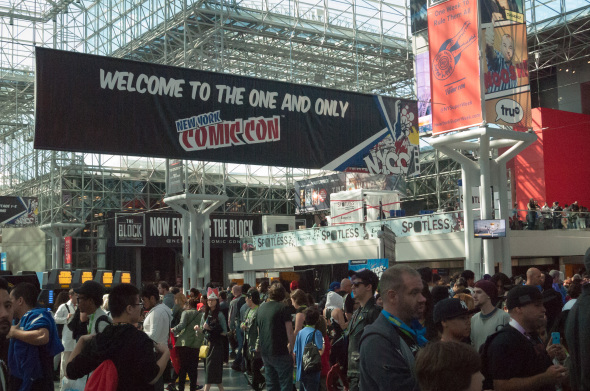
In a city known for its collection of peculiar sights – everything from topless women in Times Square, to breakdancers on subway platforms – the scene inside the Jacob Javits Center the weekend of October 9 may have been one of the most unusual yet.
Over 150,000 people attended New York Comic Con, a convention for pop culture aficionados – many of whom dressed in costumes as diverse as superheroes, cartoon characters and movie villains – all to meet celebrities, swap collectibles and learn about the latest in television and film.
The event has become a phenomenon in the city, growing in to a four-day extravaganza that dwarfs the original party of 33,000 that kicked off in 2006. Today, fans have the opportunity to spend as much as $800 on figurines and busts of their favorite characters, as well as mingle with the likes of actors Jared Leto and Mark Ruffalo, who both attended wearing rubber masks.
Not coincidentally, the growth of New York Comic Con reflects an explosion of interest across the country in all things nerdy. While in the past, some Comic Con goers may have been embarrassed as adults to openly share their interests in comic books, anime – a style of Japanese animation – or science fiction, many are now embracing their fandom.
“It’s OK now to be a nerd,” said Dr. Peter Coogan, co-founder of the Comic Arts Conference and board member at the Institute for Comic Studies, an organization that promotes the study and legitimacy of comics. “The nerds have taken over.”
The entertainment industry has followed the trend. Television shows like “Scorpion” and “The Big Bang Theory” showcase groups of highly intellectual characters solving crimes and dating pretty girls. Movies like “The Social Network” and “Steve Jobs” demonstrate the levels of wealth and power that have been attained by computer entrepreneurs. Since 1999, Amazon founder Jeff Bezos, Microsoft founder Bill Gates and Facebook founder Mark Zuckerberg have all received the honor of Time Magazine’s “Person of the Year.”
“I think it’s driven by the importance of computers and the fact that people who are interested in computers are interested in very geeky things,” said Coogan. “As they prospered and got money, they didn’t feel any pressure to grow up in terms of their choices of escapist entertainment.”
Much of the money generated by the computer age has gone into funding the hobbies highlighted at Comic Con. Of the top 20 grossing movies of all time, 14 have been released since 2000. Six of those movies take their storylines from comic books and another 13 of the top 20 include elements of animation or science fiction.
Sales of graphic novels, a medium that evolved from comic books, grew 10 percent in 2014 and now register sales of more than $850 million dollars per year, according to Nielsen Bookscan.
Brandon Crespo, 21, attended his sixth Comic Con this year, but came in costume for the first time. Dressed as Arnold, from the Nickelodeon series “Hey Arnold,” complete with a hand-drawn football-shaped mask, he said, “It’s awe-inspiring to see all these people I relate to. Anywhere else in the city I might get stared at, but come here and it’s like you’re part of the family.”
Other attendees expressed similar relief for not being judged because of their niche hobbies from childhood.
Chris Galpin and Adam Jara are longtime friends who were first exposed to superheroes in the days of Saturday morning cartoons. They attended Comic Con together for the fourth time.
“It’s definitely more socially accepted now,” said Jara. “Some [attendees] are upset that it’s become more crowded, but the more the merrier.”
Society’s willingness to indulge fantasies of Spiderman and the Silver Surfer – the superheroes Jara and Galpin chose to dress as during the convention – may even stem from geopolitical forces.
“Superheroes reflect an American status as a global superpower and the need for America to feel like an indispensable nation,” said Coogan. Today, going to the movies or picking up a comic book is a metaphorical way to witness the United States fight terrorism or mediate world peace, he said.
Ultimately, the answer to Comic Con’s growing popularity may even come down to nature. Neil Cohn, a researcher at the University of California, San Diego, studied the brain waves of people reading comics. Trials found that certain people showed greater neural stimulation while reading comic books than others. “Just like novels are written in English, comics are written in a visual language,” says Cohn on his website, where he explains that similar to foreign language aptitude, some people are hardwired to understand comic books.
It’s an explanation that makes sense to Crespo. “My dad is a toy collector,” he said. “Our house was full of toys. All of that exposure is probably why I’m here today.”